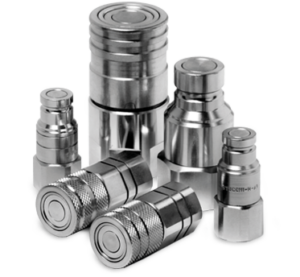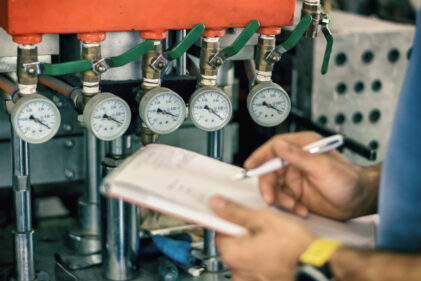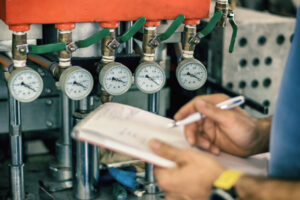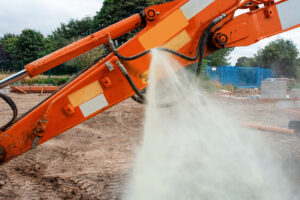Table of Contents
- 1 Hydraulic Systems: Understanding Pressure Ratings
- 2 What are Working and Burst Pressure Ratings?
- 3 The Importance of Correct Pressure Ratings
- 4 How Pressure Ratings Are Determined
- 5 Safety Factors in Pressure Ratings
- 6 Factors Influencing Pressure Ratings
- 7 Stucchi’s Pressure Ratings for Hydraulic Components
This guide unravels the complexities of pressure ratings to equip you with the knowledge needed to choose the right hydraulic components, enhancing both system performance and reliability.
Hydraulic Systems: Understanding Pressure Ratings
Hydraulic systems are integral to many industries, powering everything from construction machinery to industrial equipment. The effectiveness and safety of these systems hinge significantly on understanding and applying correct pressure ratings.
These ratings help ensure that components can handle the hydraulic pressures they encounter during operation without failure.
Key terms essential to mastering this topic include:
- Working Pressure: This is the normal operating pressure at which a hydraulic system is designed to function.
- Burst Pressure: This refers to the maximum pressure that a component can withstand before failing or bursting.
- Safety Factor: A critical ratio that compares the burst pressure to the working pressure, providing a buffer to ensure component integrity under stress.
These fundamental concepts are crucial for selecting appropriate components and ensuring the longevity and safety of hydraulic systems. A clear understanding of working and burst pressure ratings, along with the calculated safety factor, allows engineers and technicians to design systems that are not only efficient but also capable of handling unexpected pressure surges without failure. This knowledge is essential for maintaining the integrity and reliability of hydraulic systems across various applications.
VIDEO – WORKING & BURST PRESSURE RATINGS
What are Working and Burst Pressure Ratings?
Working Pressure
Working pressure, also known as operating pressure, is the average pressure at which a hydraulic system is designed to operate under normal conditions. This pressure is crucial because it determines the safe limits within which the system components like hoses, fittings, and couplers are expected to perform without risk of wear or failure. It is typically less than the maximum pressure the system can handle, ensuring a margin of safety. The maximum working pressure is often determined by the maximum output of the system’s pump, the settings of a pressure relief valve, or the highest pressure noted under full load conditions.
Burst Pressure
Burst pressure is the maximum pressure a component can withstand before it fails or ruptures. It is a critical safety measure, typically tested and reported by manufacturers after rigorous testing according to industry standards such as ISO 18869 for hydraulic quick disconnects. Burst pressure is significantly higher than working pressure, providing a buffer to accommodate unexpected spikes in system pressure. This rating is vital for preventing catastrophic failures and ensuring the safety and integrity of the hydraulic system.
Understanding these two ratings helps in selecting the right components that can safely handle normal operating conditions and withstand potential pressure peaks or malfunctions within a hydraulic system. These ratings are essential for ensuring that systems operate safely at their intended performance levels without risking damage or downtime due to pressure-related failures.
The Importance of Correct Pressure Ratings
Proper pressure ratings are fundamental to the safety and efficiency of hydraulic systems. These ratings ensure that each component can handle the specific pressures it will encounter during normal operations and in unexpected situations. By adhering to these guidelines, systems can operate smoothly without the risk of premature wear or catastrophic failures.
Impact on System Safety and Efficiency
The right pressure ratings prevent the over-exertion of hydraulic components, which can lead to leaks, bursts, and overall system failures. When components are matched with their correct working and burst pressure ratings, the system maintains optimal performance, reducing the energy required to operate effectively. This alignment not only enhances the longevity of the system but also ensures it operates at peak efficiency, thereby conserving energy and reducing operational costs.
Potential Risks of Incorrect Pressure Ratings
Using components that do not meet the required pressure ratings for a particular system can have severe consequences:
- Safety Hazards: Incorrect pressure ratings can lead to component failure, which might cause high-pressure leaks or bursts, posing serious risks to operational safety.
- System Downtime: Failures due to inadequate pressure ratings can result in significant downtime, necessary repairs, and replacement of parts, all of which contribute to increased operational costs and potential revenue loss.
- Reduced Lifespan of Components: Components operating under conditions they are not rated for are likely to wear out prematurely, leading to more frequent replacements and higher maintenance costs.
Correct pressure ratings are crucial for maintaining the integrity, safety, and efficiency of hydraulic systems. Ensuring that all components are rated appropriately for their specific roles within a system is essential to prevent failures, maximize operational uptime, and safeguard the workplace.
How Pressure Ratings Are Determined
Testing and Standards
The determination of pressure ratings, particularly burst pressure, is a meticulous process governed by specific testing methods and adherence to established industry standards. This ensures that all hydraulic components meet the necessary safety and performance requirements before they are deployed in operational settings.
Testing Methods for Determining Burst Pressure
Burst pressure testing is a critical evaluation that measures the maximum pressure a component can withstand before failing. For instance, many manufacturers, including Stucchi, utilize standards such as ISO 18869 to conduct burst tests. This standard specifies the testing procedures to be followed, ensuring that the tests are rigorous and replicable. During a burst test, the component, such as a hydraulic hose or coupler, is subjected to increasing pressure until it fails. This test helps define the maximum pressure limit for the component, which is crucial for ensuring safety across various applications.
 Role of Industry Standards
Role of Industry Standards
Industry standards play a pivotal role in ensuring that pressure ratings are not only consistent but also safe across all hydraulic components. Standards such as ISO (International Organization for Standardization) provide guidelines and specifications that manufacturers must follow. These standards help harmonize testing procedures, rating systems, and safety criteria, ensuring that components manufactured in different locations or by different companies are compatible and can safely be used in diverse hydraulic systems.
Adhering to these standards guarantees that components are tested under uniform conditions and meet minimum safety thresholds before they reach the market. This uniformity is essential for system designers and engineers who rely on these ratings to select the right components for their hydraulic systems, ensuring optimal performance and safety.
By following these rigorous testing methods and standards, manufacturers can provide accurate, reliable pressure ratings that users can trust when designing or maintaining hydraulic systems. This adherence to high testing standards is critical for preventing equipment failure and ensuring the longevity and reliability of hydraulic operations.
Safety Factors in Pressure Ratings
A safety factor in hydraulic systems is a critical engineering tool designed to provide a margin of safety by reducing the risk of component failure. It is the ratio of the burst pressure to the working pressure of a component. This factor ensures that the component can handle unexpected surges or spikes in pressure beyond its normal operating conditions without failure.
Importance and Common Values
The safety factor is crucial because it accounts for uncertainties in system conditions, variations in material properties, and potential degradation over time. Common safety factor values in hydraulic applications typically range from 3 to 4 or higher, depending on the criticality and expected variability of the operating conditions. In standard applications, a safety factor of 4 is generally acceptable, providing a robust buffer against most operational unpredictabilities. However, in specialized applications where conditions are more controlled or less variable, a safety factor of 3 may be sufficient.
Factors Influencing Pressure Ratings
When selecting hydraulic components, it’s essential to consider factors that can affect their pressure ratings:
- Coupler Gender and Connection State: The gender of a coupler (male or female) and whether it is connected or disconnected can significantly influence its pressure rating.
- Material and Design: The materials used in components and their design also impact their ability to withstand pressure. Components designed with robust materials and optimized flow paths can handle higher pressures and thus have higher pressure ratings.
Consider a scenario where a hydraulic system needs to operate near its maximum working pressure; choosing components with higher safety factors and appropriate pressure ratings for each connection state (connected, male disconnected, or female disconnected) is crucial. For instance, if a system includes frequently connected and disconnected couplers, selecting quick disconnects that maintain robust pressure ratings in all connection states enhances system reliability and safety.
Understanding these factors and how they affect pressure ratings helps ensure that the selected hydraulic components are not only suitable for the intended application but also capable of performing safely and efficiently under varying operational conditions. This careful selection process mitigates the risks of component failure, optimizing system performance and extending the lifecycle of the hydraulic equipment.
VIDEO – WORKING & BURST PRESSURE RATINGS
Stucchi’s Pressure Ratings for Hydraulic Components
Stucchi is committed to providing high-quality, reliable hydraulic components that meet the strictest safety standards. Here’s a step-by-step guide on how to find the working and burst pressure ratings for Stucchi products, ensuring you select the right components for your hydraulic systems:
- Visit the Stucchi Website or Catalog: Every product on Stucchi’s website lists working pressure, burst pressure, and max residual pressure during connection, as part of the properties chart, searchable by each term:
 Stucchi’s extensive Product Catalog is also available to help you find detailed information about each product.
Stucchi’s extensive Product Catalog is also available to help you find detailed information about each product.
- Select the Product Series: Identify the specific product series that interests you. Each series is designed for different applications and features unique characteristics that are suitable for various hydraulic needs.
- Locate the Specification Section: After selecting a product series, scroll down to view the specifications for that series. Here, you will find comprehensive details about the products, including their working and burst pressure ratings.
- Review Pressure Ratings: On the specification chart, look for the pressure ratings listed under the product. These ratings are clearly displayed to provide easy access to crucial data. Make sure to note both the working pressure and the burst pressure.
- Understand Application-Specific Ratings: If your application involves unique conditions or extreme variations in pressure, consult the detailed notes and exceptions provided on the specification page to ensure compatibility and safety, or contact a Stucchi hydraulic specialist for support.
You can also find Stucchi’s Hydraulic Pressure Drop Chart with each product’s description on our website, and learn more about pressure drop with our comprehensive guide: Understanding Hydraulic Pressure Drop: Enhancing System Efficiency and Reliability.
Adherence to Testing Standards and Quality Assurance
Stucchi takes pride in our rigorous adherence to international testing standards such as ISO 18869, which ensures that all components are tested under standardized conditions to determine their pressure ratings accurately. This commitment to quality assurance means:
- Reliability: Each product is tested to withstand pressures beyond its rated capacity, ensuring it performs safely under normal and extreme conditions.
- Consistency: Adhering to global standards guarantees that Stucchi products maintain uniform quality and performance, regardless of where they are used.
- Transparency: Stucchi provides detailed testing information and pressure ratings for customers, fostering trust and confidence in the suitability of its products for various hydraulic applications.
By following these guidelines, you can confidently select Stucchi hydraulic components that meet your system’s requirements, backed by a commitment to safety, quality, and performance.
Understanding and applying the correct working and burst pressure ratings in hydraulic systems is not just a best practice—it is essential for ensuring the safety, efficiency, and longevity of equipment. By adhering to established standards and selecting the right components based on accurate pressure ratings, system designers and operators can prevent failures, minimize operational costs, and maintain optimal performance throughout the lifecycle of their hydraulic systems. For answers to all your questions about connecting under pressure, discover Stucchi’s Connect Under Pressure (CUP) hydraulic solutions.
Stucchi remains dedicated to providing industry-leading solutions with a strong emphasis on reliability and safety. Our experts are on hand to assist with selecting the right hydraulic components customized to your specific needs. Contact us to learn more about our products and how to determine working pressure and burst pressure for the safety of your hydraulic systems.




